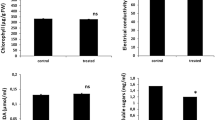Abstract
In this study, SSH (Suppression Subtractive Hybridization) and cDNA microarray were used to identify genes associated with waterlogging response of maize roots. Mo17 and Hz32 are two maize inbred lines with differential tolerance to hypoxia. Seedlings of the inbred lines with two leaves were submerged in hypoxia buffer. SSH libraries were constructed with cDNA samples from roots. Both forward and reverse subtractions were performed for each inbred line, and 105 positive clones induced by hypoxia were selected by differential screening. The treated and control message RNA were hybridized with the cDNA microarray of Mo17, sequentially, 57 of 3-fold differentially expressed clones were obtained. A total of 162 positive clones were all sequenced. Bioinformatics analysis showed these positive clones represent 85 TUGs, including genes involved in several biochemistry pathways, such as glycolysis, protection, signal transduction, cell construction and energy metabolism and 41 EST with unknown function. Comparison between Mo17 and Hz32 indicates that genes related to hypoxia tolerance have different expression patterns in submerged roots. Several positive clones’ expression patterns were revealed by Northern or RT-PCR, and a new gene (Sicyp51), which may contribute to hypoxia tolerance, was identified.
Similar content being viewed by others
References
Dennis, E. S., Dolferus, R., Ellis, M. et al., Molecular strategies for improving waterlogging tolerance in plants, J. Exp. Bot., 2000, 51:89–97.
Subbaiah, C. C., Sachs, M. M., Molecular and cellular adaptations of maize to flooding stress, Ann. Bot. (Lond.), 2003, 91: 119–127.
Chang, W. W. P., Huang, L., Shen, M. et al., Patterns of protein synthesis and tolerance of anoxia in root tips of maize seedlings acclimated to a low-oxygen environment, and identification of proteins by mass spectrometry, Plant Physiol., 2000, 122: 295–318.
Sachs, M. M., Subbaiah, C. C., Saab, I. M., Anaerobic gene expression and flooding tolerance in maize, J. Exp. Bot., 1996, 47: 1–15.
Ahlan, G., Pearce, D. M., Jackson, M. B. et al., Characterization of programmed cell death during aerenchyma formation induced by ethylene or hypoxia in roots of maize (Zea mays L.), Planta, 2001, 212:205–214.
Drew, M. C., He, C. J., Morgan, P. W., Programmed cell death and aerenchyma formation in roots, Trends Plant Sci., 2000, 5: 123–127.
Huq, E., Hodges, T. K., An anaerobically inducible early (aie) gene family from rice, Plant Mol. Biol., 2000, 40: 591–601.
Gao, P., Wang, G. Y., Zhao, H. J. et al., Isolation and identification of submergence-induced genes in maize (Zea mays) seedlings by suppression subtractive hybridization, Acta Bot. Sin., 2003, 45: 479–483.
Dolferus, R., Jacobs, M., Peacock, W. J. et al., Differential interactions of promoter elements in stress responses of the ArabidopsisAdh gene, Plant Physiol., 1994, 105: 1075–1087.
Hoeren, F. U., Dolferus, R., Wu, Y. R. et al., Evidence for a role for AtMYB2 in the induction of the Arabidopsis alcohol dehydrogenase gene (ADH1) by low oxygen, Genetics, 1998, 149: 479–490.
Olive, M. R., Walker, J. C., Singh, K. et al., Functional properties of the anaerobic response element of the maize Adh1 gene, Plant Mol. Biol., 1990, 15: 593–604.
Klok, E. J., Wilson, I. W., Wilson, D. et al., Expression profile analysis of the low-oxygen response in Arabidopsis root cultures, Plant Cell, 2002, 14: 2481–2494.
Jiang, H. W., Zhang, Z. X., Measuring the waterlogging tolerance level of maize germplasm and fundamental study on waterlogging tolerance heritage, Journal of Hubei Agricultural College, 1999, 19(2): 188–189.
Rhee, C. H., Hees, K., Jabbur, J. et al., cDNA expression array reveals heterogeneous gene expression profiles in three glioblastoma cell lines, Oncogene, 1999, 18:2711–2717.
Xu, L., Hui, L., Wang, S. et al., Expression profiling suggested a regulatory role of liver-enriched transcription factors in human hepatocellular carcinoma, Cancer Res., 2001, 61: 3176–3181.
Sambrook, J., Fritsch, E. F., Maniatis, T., Molecular cloning: A laboratory manual, 2nd ed., NY: Cold Spring Harbor Laboratory, 1989.
Edwards, P. A., Ericsson, J., Sterols and isoprenoids: Signal molecules derived from the cholesterol biosynthetic pathway, Annu. Rev. Biochem., 1999, 68: 157–185.
He, J. X., Fujioka, S., Li, T. C. et al., Sterols regulate development and gene expression in Arabidopsis, Plant Physiol., 2003, 131: 1258–1269.
Pina, C., Santos, C., Couto, J. A. et al., Ethanol tolerance of five non-Saccharomyces wine yeasts in comparison with a strain of Saccharomyces cerevisiae influence of different culture conditions, Food Microbiol., 2004, 21: 439–447
Larue, F., Lafon-Lafourcade, S., Ribereau-Gayon, P., Relationship between the sterol content of yeast cells and their fermentation activity in grape must, Appl. Env. Microbiol., 1980, 39: 808–811.
Lewis, T. E., Nichols, P. D., McMeekin, T. A., Sterol and squalene content of a docosahexaenoic-acid-producing thraustochytrid: Influence of culture age, temperature, and dissolved oxygen, Mar. Biotechnol., 2001, 3:439–447.
Valachovic, M., Hronska, L., Hapala, I., Anaerobiosis induces complex changes in sterol esterification pattern in the yeast Saccharomyces cerevisiae, FEMS Microbiol. Lett., 2001, 197: 41–45.
Mauricio, J. C., Moreno, J., Zea, L. et al., The effects of grape must fermentation conditions on volatile alcohols and esters formed by Saccharomyces cerevisiae, J. Sci. Food Agric., 1997, 75: 155–160.
Swan, T. M., Watson, K., Stress tolerance in a yeast sterol auxotroph: Role of ergosterol, heat shock proteins and trehalose, FEMS Microbiol. Lett., 1998, 169: 191–197.
Diatchenko, L., Lau, Y. F., Campbell, A. P. et al., Suppression subtractive hybridization: A method for generating differentially regulated or tissue-specific cDNA probes and libraries, Proc. Natl. Acad. Sci. USA, 1996, 93: 6025–6030.
Author information
Authors and Affiliations
Corresponding author
Rights and permissions
About this article
Cite this article
Tang, W., Zhang, Z., Zou, X. et al. Functional genomics of maize submergence tolerance and cloning of the related gene Sicyp51 . Sci. China Ser. C.-Life Sci. 48, 337–345 (2005). https://doi.org/10.1360/062004-27
Received:
Issue Date:
DOI: https://doi.org/10.1360/062004-27




